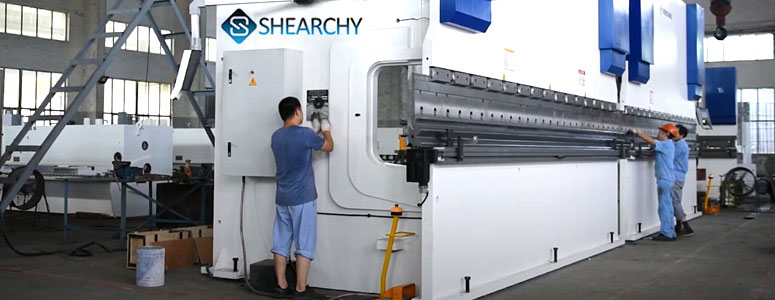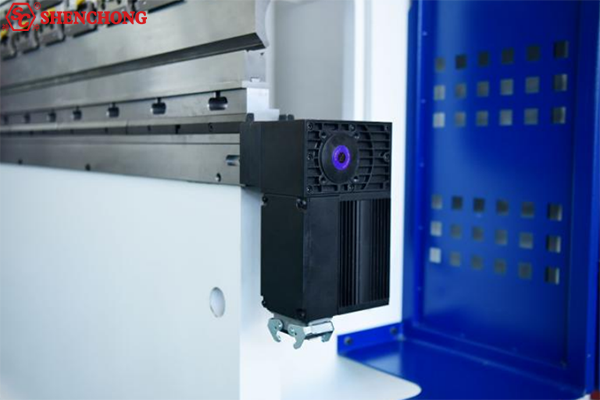Purchase press brake machine is a necessary investment in a sheet metal processing factory, and so it is very important for all customers know how to choose a press brake that can perfectly bend workpieces. This article introduces five attention points customers need to know before they purchase press brake machines.
1. Workpieces:
The first important point to consider is the workpiece customers want to produce, and all customers goal is to buy a press brake that can complete the bending task with the shortest table and the smallest tonnage. To choose the perfectly matched machine model, customers should carefully consider their plate material grades, plate maximum thickness and length. If most of the work is mild steel with a thickness of 2mm and a maximum length of 3000mm, the bending force need not be greater than 50 tons. However, if you are doing a lot of bottomed die forming, maybe a 160 ton machine should be considered.
Well, assuming the max. material thickness is 6mm, max. Length is 3000mm, the bending force requires 200 tons, and bottomed die bending (corrected bending) requires at least 450 tons. If the majority of workpieces are 1500mm or less, the tonnage is almost halved, greatly reducing the purchasing cost. In this case, choose the machine model based on workpiece is very important.
2. Deflection
Under the same load, the deflection of the 3000mm press brake machine table and slider is 4 times that of the 1500mm machine. That said, shorter press brake requires less shim adjustment to produce acceptable parts. Reduced shim adjustment in turn reduces setup time.
Material grade is also a key factor. Compared to mild steel, stainless steel typically requires around 50% more load, while most grades of soft aluminium require around 50% less. You can always get a press brake tonnage table from the press brake manufacturer that shows an estimate of the tonnage required per foot of length for different thicknesses and materials.
The old fashion hydraulic NC press brake needs customers to pay very attention to table deflection because this is the key point to affect the bending precision, but now CNC press brake machine can automatically adjust the deflection by its CNC controller.
3. Bending radius of workpieces:
When bending the workpieces, the bending radius is 0.156 times the opening distance of the die. During the bending process, the opening distance of the die should be 8 times the thickness of the metal material. For example, when forming 2mm mild steel using a 12.7mm gap, the part has a bend radius of about 1.98mm. If the bending radius is almost as small as the material thickness, a bottomed die forming is required. However, the pressure required for forming a bottomed die is about 4 times greater than that of free bending.
If the bending radius is smaller than the material thickness, a punch with a front-end fillet radius smaller than the material thickness must be used, and the imprint bending method must be resorted to. In this way, 10 times the pressure of free bending is required. For free bending, punches and dies are machined at 85° or less (smaller is better). When using this set of dies, pay attention to the gap between the punch and die at the bottom of the stroke, and the overbending enough to compensate for springback to keep the material around 90°. Generally, the springback angle produced by the free bending die on the new bending machine is ≤2°, and the bending radius is equal to 0.156 times the opening distance of the die. For bottomed die bending, the die angle is generally 86 to 90°. At the bottom end of the stroke, there should be a gap slightly larger than the material thickness between the punch and the punch. The forming angle is improved because the bottomed die bends to a higher tonnage (approximately 4 times that of a free bend), reducing the stresses that normally cause springback within the bend radius.
Imprint bending is the same as bottomed die bending, except that the front end of the punch is processed to the required bending radius, and the punch and die gap at the bottom of the stroke is smaller than the material thickness. Springback is essentially avoided by applying enough pressure (about 10 times the free bend) to force the front end of the punch into contact with the material. In order to select the lowest tonnage specification, it is best to plan for a bend radius greater than the material thickness and use the free bending method whenever possible. When the bending radius is large, the quality of the finished part and its future use are often not affected.
4. Bending Precision of the Press Brake Machine:
The bending accuracy requirement is a factor that needs to be carefully considered. It is this factor that determines whether you need to consider a CNC press brake machine or a NC hydraulic press brake. If the bending accuracy requires ±1° and cannot be changed, you must purchase CNC press brake machine.
The repeatability precision of the CNC hydraulic press brake slider is ±0.01mm, and the precise angle must be formed with such precision and a good mold. The repeatability precision of the NC hydraulic press brake machine slider is ±0.05mm, and the deviation of ±2~3° will generally occur under the condition of using a suitable mold. In addition, CNC press brakes are ready for rapid die set-up, which is an undeniable reason to consider when you need to bend many low-volume parts.
5. Purchase Press Brake Machine Tools:
Even if you have a shelf full of press brake tools, do not think that these tools are suitable for newly bought press brake machines. You need to ensure the height of the press brake upper punch and lower dies plus press brake stroke larger than press brake machine opening height.
For conventional molds, the deviation per foot should be around ±0.025mm, and the total length deviation should be no more than ±0.127mm. For fine grinding dies, the accuracy should be ±0.01mm per 25.4mm, and the total accuracy should not be greater than ±0.05mm. It is best to use fine ground dies for CNC press brakes and regular dies for NC press brake.
In conclusion, to purchase press brake machine, it is necessary for customers to consider workpieces, press brake deflection, bending radius, bending precision and press brake tools.


